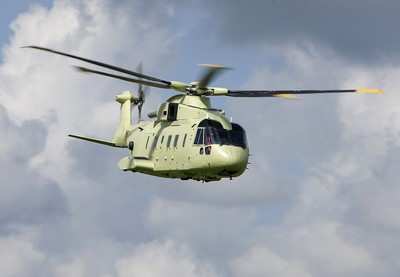Fri, May 08, 2009
$17 Billion Cut... But Trillions More Spent Elsewhere
The Obama Administration, in the process of spending trillions
of dollars for all manner of programs and projects, is trumpeted
the 17 Billion dollars it is trying to cut from the Federal Budget.
Rather than try to digest them all en masse, we'll look at each of
them one at a time and allow you to make up YOUR mind as to the
rationale and wisdom for the decisions included below. Herewith;
another of the programs on the chopping block that has an aviation
or aerospace connotation.

From the 'Terminations, Reductions, and Savings' document
published this week by the OMB, as part of the FY 2010 US
Budget:
Proposal: The Administration proposes to
terminate the Presidential Helicopter replacement (VH-71) program
and to initiate a new Presidential Helicopter replacement program,
and to properly develop options for a fiscal year 2011 follow-on
program. The Presidential Helicopter is responsible for the safe,
reliable transport of the President in administrative and
contingency environments, worldwide. The VH-71 is being developed
to replace the existing VH-3D and VH-60N helicopters, which
currently serve as "Marine One".

Justification: The VH-71 program is six years
behind schedule, and its cost has grown from $6.5 billion to over
$13 billion. Over $3.2 billion has already been spent on this
program with no operational aircraft delivered. The Government
Accountability Office has warned that future costs of the VH-71 are
unknown, and the Congressional Research Service has raised the
question if the current program should be cancelled. These high
costs and schedule slippage have occurred because of challenging
program requirements and an ambitious schedule. Instead of
continuing to pursue the current program, the Administration
proposes to cancel it, review requirements, and establish a new
program. A new Presidential Helicopter replacement program will
allow the Administration to take advantage of new technologies and
develop a helicopter that is fiscally responsible while still
meeting the President's requirements.

Funding in 2010 will cover termination costs, Government efforts
to develop options for a Presidential Helicopter replacement
program, and service life extensions for the current Presidential
Helicopter fleet.
More News
Light Gun A handheld directional light signaling device which emits a brilliant narrow beam of white, green, or red light as selected by the tower controller. The color and type of>[...]
"The journey to this achievement started nearly a decade ago when a freshly commissioned Gentry, driven by a fascination with new technologies and a desire to contribute significan>[...]
Aero Linx: JAARS, Inc. For decades now, we’ve landed planes on narrow rivers and towering mountains. We’ve outfitted boats and vehicles to reach villages that rarely se>[...]
"Our driven and innovative team of military and civilian Airmen delivers combat power daily, ensuring our nation is ready today and tomorrow." Source: General Duke Richardson, AFMC>[...]
Aircraft Conflict Predicted conflict, within EDST of two aircraft, or between aircraft and airspace. A Red alert is used for conflicts when the predicted minimum separation is 5 na>[...]
 ANN's Daily Aero-Term (04.20.24): Light Gun
ANN's Daily Aero-Term (04.20.24): Light Gun Aero-News: Quote of the Day (04.20.24)
Aero-News: Quote of the Day (04.20.24) ANN's Daily Aero-Linx (04.21.24)
ANN's Daily Aero-Linx (04.21.24) Aero-News: Quote of the Day (04.21.24)
Aero-News: Quote of the Day (04.21.24) ANN's Daily Aero-Term (04.21.24): Aircraft Conflict
ANN's Daily Aero-Term (04.21.24): Aircraft Conflict





